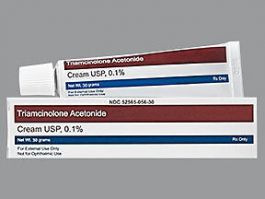

your development or check for drug side effects Tell all your doctors that you use (or have used) Triamcinolone Acetonide cream Tell your doctor or pharmacist your medical history, especially problems with the immune system, poor blood circulation.

If you use Triamcinolone Acetonide cream for a long time or apply it to large areas of your body, you may need tests, such as regular adrenal function tests, to monitor your progress.
Triamcinolone acetonide ointment 0.1 skin#
Drug interactions with Triamcinolone Acetonide creamĭo not share Triamcinolone Acetonide cream with others Do not use Triamcinolone Acetonide for other skin conditions, unless your doctor tells you to. If you notice any other side effects not listed above, contact your pharmacist or doctor. This is not a complete list of possible side effects. Therefore, seek medical help immediately if you notice any symptoms of this allergic reaction. Rash, itching/swelling (especially of the face/tongue/throat), severe dizziness, trouble breathing: These are symptoms of a very serious allergic condition, but this is very rare. Tell your doctor right away if any of the following side effects occur: extreme tiredness, weight loss, headache, swelling ankles/feet, increased thirst/urination, vision problems force. However, systemic side effects can still be experienced when Triamcinolone Acetonide cream is used in children and people who use it for a long time or over large areas of skin. Systemic side effects: Rarely, topical corticosteroids can be absorbed from the skin into the bloodstream and cause many systemic side effects. Stretch marks, thinning or discolored skin, acne, hirsutism, folliculitis Worsening of pre-existing skin infections with the use of this medicine. If any of these effects persist or get worse, tell your doctor or pharmacist right away for advice.
Triamcinolone acetonide ointment 0.1 how to#
How to use Triamcinolone Acetonide cream?ĭuring the use of Triamcinolone Acetonide cream, you may experience some of the following side effects: Burning, itching, irritation or dryness of the skin may occur if it is the first time using the drug, however this condition This will go away after a few days as your body adapts to the medicine. Itching of flat Lichen: red patches of skin that become thickened and discolored from excessive rubbing or scratching. The disease is rare but difficult to diagnose, and doctors can diagnose PG after ruling out other conditions and through the rapidly progressive, indistinct ulceration of the disease. Pyoderma gangrenosum (PG) is a condition in which skin sores form. Anal itching can be caused by many causes such as skin diseases, hemorrhoids, poor hygiene, too much washing, etc. Itchy anus: This is a severe and persistent itching in the area around the anus. Scalp psoriasis: is a common skin condition, red and white patches of skin with clear boundaries and very easy to peel and bleed accompanied by itching and hair loss, The difficulty of treating scalp psoriasis can make you quite uncomfortable even depressed if you are ridiculed or someone says something bad. Plaque psoriasis: This is a type of psoriasis characterized by red, dry patches of skin with white scales on top, may be accompanied by painful itching. Diagnosis of GA is clinical and can be done by biopsy. The disease is characterized by papules arranged in arcs or centrioles that surround normal or concave skin.

Eczema: A type of allergy that causes red and itchy skin Contact Dermatitis: A type of skin rash caused by direct contact with an irritant Atopic Dermatitis Discoid Eczema Angioedema (GA): This is a chronic skin disease and benign. SD is diagnosed based on clinical examination, but the disease is difficult to distinguish from other diseases such as psoriasis, contact dermatitis, atopic dermatitis. with dry or greasy scaling of the scalp, more severe may have yellow-red papules.

The disease usually develops gradually and often manifests itself. Seborrheic Dermatitis (SD): This is an inflammatory skin condition that mainly occurs in areas of the skin with many sebaceous glands such as the scalp, face, upper body, etc. In the early stages, the histopathology in biopsies may not be obvious. Diagnosis of the disease is based on clinical symptoms, laboratory results and skin biopsy results. The disease often has an indistinct onset, sometimes with only chronic redness at first. Triamcinolone Acetonide cream is used in the treatment of conditions such as: Skin T-cell lymphoma (CTCL): This is a rare disease, including mycosis (MF) and Sézary syndrome (SS), mainly Affects skin and lymph nodes.


 0 kommentar(er)
0 kommentar(er)
